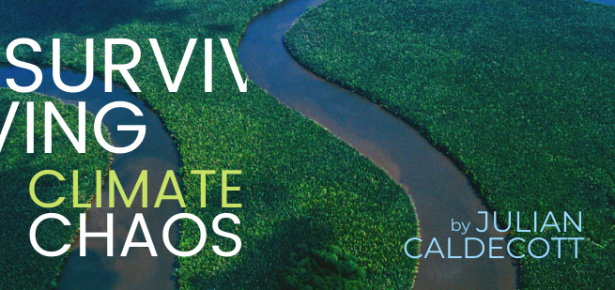
Surviving Climate Chaos is being published into a new world of lethal fires, floods and record-breaking temperatures, as well as frantic international negotiations before CoP 26 in Glasgow. This is while the IPCC warns us that we are in the last decade before Arctic, oceanic and equatorial tipping points take all choices out of human hands. This emergency calls for far greater focus and impact in our climate change response, and for the strengthening of communities and ecosystems everywhere against climate chaos.
Mitigation.
People working on humanity’s response to the threat of climate change call anything that reduces net GHG emissions ‘mitigation’. Inside that statement is a lot of complexity. There are many ways to reduce emissions, and some are slower or faster, or more or less certain, than others. So there is often a trade-off between doing something that is certain to work but only slowly, like building a wind farm, and something that could deliver far more carbon savings more quickly but with greater risk, like conserving a forest. And there are also slow and indirect ways with enormous potential, like building the capacity of a government to make sound decisions on decarbonising its economy and conserving its ecosystems. But these are vulnerable to political accidents and incidents so they only work sometimes. But how to choose among them all?
Net mitigation.
One difficulty is with what ‘net’ means in reducing emissions. This shouldn’t be a problem, since it obviously means the amount of GHG conserved after all the positive and negative effects have been calculated for the whole system involved. If parts of that system have to be ignored to make the sums add up to ‘net zero’ or ‘net negative’, then it isn’t. But it can be hard to find all the right information, what with goods being made in one country and used in another, and different records being kept in each. And often the actions that conserve GHGs also produce them, like the emissions from making and managing wind turbines. Politicians can exploit these complexities by pretending that their policies are better than they are. And corporations can use them to ‘greenwash’ their products, by claiming that GHGs produced in one place or process are ‘off-set’ by GHGs conserved in another. Still, at least we know that real net zero or negative is what we want, and must have.
Co-benefit-aware mitigation.
Another issue is with ‘co-benefits’. These are other good things that can happen when emissions are reduced. For example, conserving carbon in natural forests can also protect biodiversity and water supplies while preventing floods and erosion, and renewable energy can help create jobs in a ‘green-growth’ economy. Environmental security and employment are very valuable to local people. But conversely, focusing only on mitigation and ignoring the potential co-benefits (and co-costs) can cause a lot of unnecessary damage and often more harm than good. Planting forests of non-native trees is disastrous for biodiversity, for instance, and uniform tree plantations are vulnerable to fire and pests, so organic farming and soil carbon capture can be better. Taking complete view that recognises all co-costs and co-benefits is utterly essential, but requires a lot of knowledge (and wisdom, and talking to people) to do well. Still, at least we know that maximising co-benefits is what we want, and must have.
Deadline-aware mitigation.
Surviving Climate Chaos covers the obvious questions of how to choose the best net and co-benefit-aware mitigation methods in diverse real-life circumstances. But it also aims to answer the new and unwelcome question of how to respond to a mid-century deadline imposed by simultaneous biophysical tipping points. Put simply, the issue is that once you step off a cliff and let gravity take over, you have no choices left. And that cliff edge and the last opportunities to choose our fate are now upon us. So we need to work out how to reduce GHG emissions in the best way possible to postpone runaway climate change, to buy a few years to make systemic changes to our entire economic system. To do this, we must build into our calculations a way to give higher mitigation value to carbon savings made sooner rather than later, and correct in this way all the calculations on which our mitigation investment choices are made. My book explains how to do this, with the aim of enabling urgent design of the most cost-effective, co-benefit and deadline aware net mitigation investment portfolios possible.
Title: Surviving Climate Chaos by Strengthening Communities and Ecosystems
Author: Julian Caldecott
Paperback ISBN: 9781108793780
Hardback ISBN: 9781108840125
Latest Comments
Have your say!